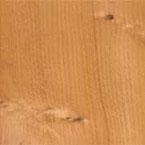|  |
| Wood of the Month:
Yew: The Strong, Pliable Softwood By Jo-Ann Kaiser | FAMILY NAME
Taxus baccata of the Family Taxaceae COMMON NAMES
Yew, common yew, European yew, yewtree HEIGHT/WEIGHT
Average height is 40 to 50 feet tall with short twisted boles but can be as short as 20 feet or as tall as 60 feet. Average weight is 42 pounds per cubic foot with a specific gravity of 0.67. PROPERTIES
Wood dries fairly rapidly and well, with little degrade although care is needed in drying or shakes may develop. Wood is hard and elastic. Medium bending and crushing strength. Low stiffness and resistance to shock loads. | Yew is a wood which has a deep history and is associated with much folklore. Yew's evergreen leaves are said to be symbolic of everlasting life. The Greeks considered yew trees sacred and associated them with Hecate, Queen of the Underworld. Christians traditionally planted yew trees in country churchyards. In her book, "Wood," Jane Struthers writes that opinion is divided on just why yews are associated with churchyards. "Some old authorities claim it is because the yew is said to ward off devils (which is why yew hedges were frequently planted near houses), while others believed it was due to yew's ability to absorb the noxious smells that floated up from the graves." Bow Wood
Once upon a time, yew wood was the wood of choice for making longbows. These archery bows were a staple in the arsenal of medieval wars. The bows are often called English longbows, but historians say wood from Spanish yew trees was better suited to making the bows than English yew. The English variety grew curvy and gnarled, while the Spanish yew grew straighter. Donald Culross Peattie writes in, "A Natural History of Western Trees," that, before the invention of gunpowder, "a good supply of yew was as important as steel as a raw material of war-making." Historical writings about famous battles attest to the importance of the longbow. In one account of a battle between the English and the French at Agincourt in the Hundred Years War, 4,000 English archers were able to defeat 65,000 French cavalry because the longbows could be shot continuously. Sir Walter Scott writes in a footnote of Ivanhoe that King Edward I "decreed that yew trees should be planted in all the English churchyards in order that there would be a plentiful supply of wood for longbows." However, the practice of planting yews started long before Edward I was king from 1272 to 1307. Some of the Oldest Trees
Yew trees are some of the oldest trees in the world. European yews routinely live hundreds of years, with the oldest of the trees being 2,000 years old. Yew's heartwood ranges in color from an orange brown to a golden orange often streaked with purple, mauve and brown. Yew grows in many places around the world and is one of the few evergreens that is native to Great Britain. The tree grows in Europe, Asia, Persia, north Africa and parts of the Himalaya Mountains. Species of Taxus are also found in the United States. Western yew - Taxus brevifolia - is also called Pacific yew and mountain mahogany. These yews can grow as tall as 75 feet. The Pacific yews have gained notoriety because bark from the tree has proven to be a very potent cancer drug. Scientists began testing plants some 30 years ago. Of the 35,000 plant species tested, yew proved the best at offering a safe, effective treatment for cancer tumors. Taxol, as the drug is called, has been used successfully to treat ovarian cancer, lung cancer and breast cancer. Initially it took the bark of six trees to equal two grams of taxol for one course of treatment against cancer tumors. Pacific yews are the best source for taxol, although taxol is present in European yews and other yews around the world. An average 100-year-old Pacific yew tree yields approximately 3 kg of bark. Today, needles from the tree are used to supply taxol, taking the strain off the supply of trees and the need to strip the trees of bark. A Hard Softwood
Yew may be classified as a softwood, but it is harder and heavier than several of the "hardwoods." It is tough, strong and resilient, and is suitable for use in bent wood applications. Yew wood was the wood of choice for the bent parts of Windsor chairs. Yew continues to have many uses today, although European yew and Pacific yew are in limited supply. European yew is used for reproduction furniture, interior and exterior joinery, outdoor furniture and fence posts. It remains a popular choice for Windsor chair parts. Yew tree trunks grow in a twisted manner affecting the wood's use in applications. Yew's irregular growth also impacts the wood's grain. It can be "unpredictable and volatile to work," according to Luke Hughes in the book, "The Encyclopedia of Wood." "This explains the desirability of yew for the creation of smaller objects such as snuff and pill boxes, plates and spoons, and even the working parts of woodmills," he wrote. Veneers cut from yew are sometimes used for furniture and high-end uses, especially for reproduction work. It is also used for carving. | 

Have something to say? Share your thoughts with us in the comments below.